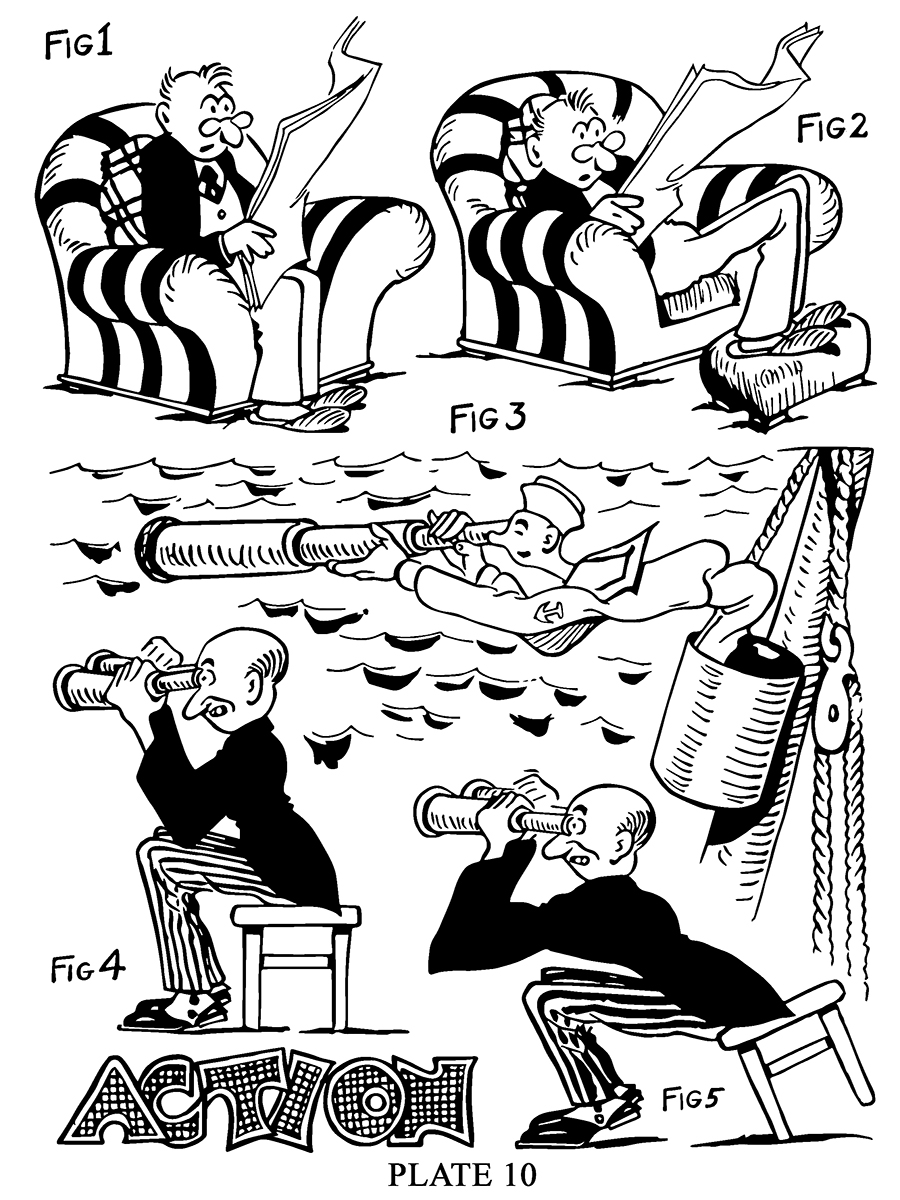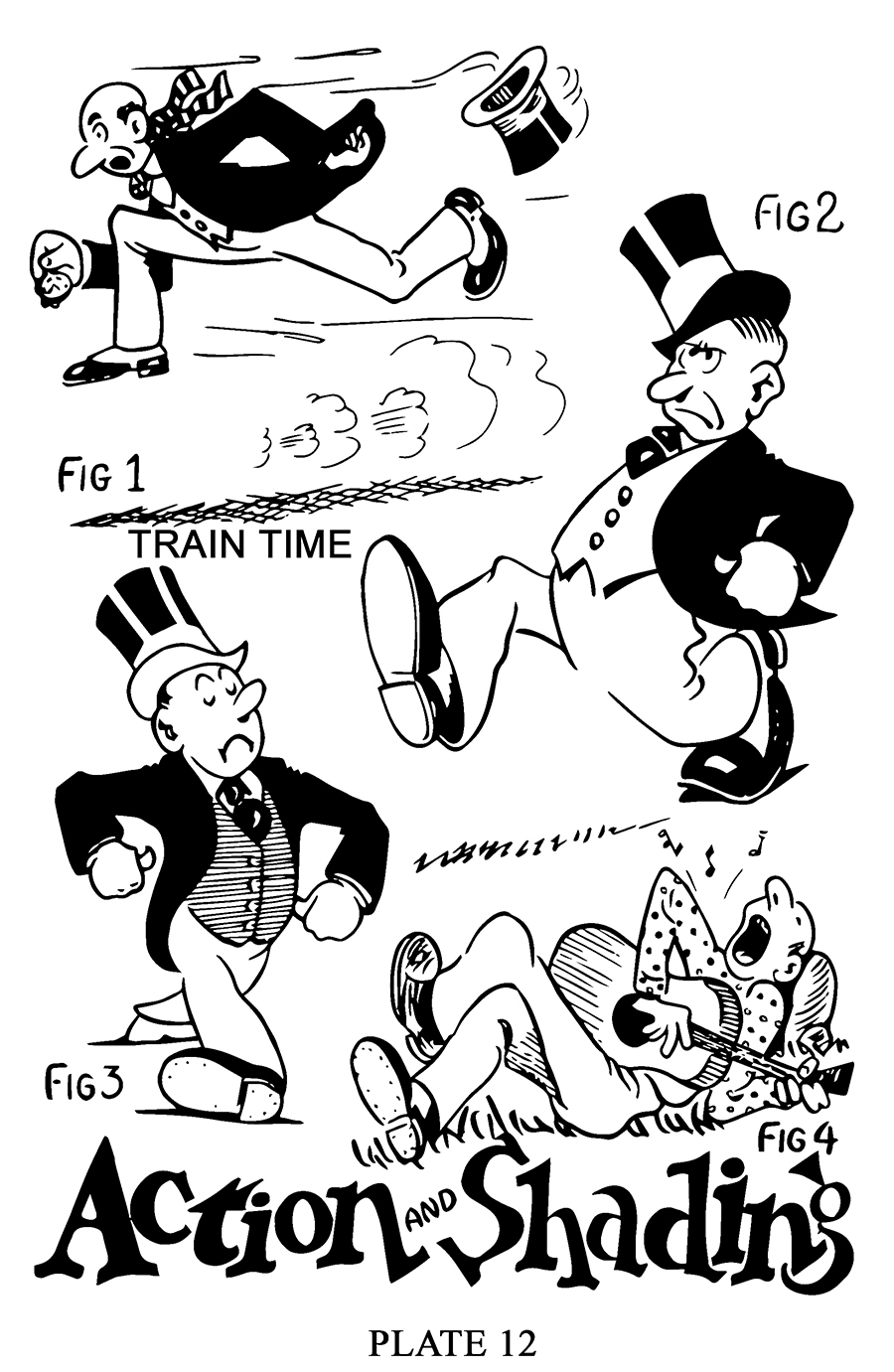 Action is all important in cartooning. It is the item that creates greatest interest in a cartoon, or cartoon composition.
Action is all important in cartooning. It is the item that creates greatest interest in a cartoon, or cartoon composition.
Of course action is exaggerated in cartoons just as expressions and forms are exaggerated. In cartoons, even though the figure is not in motion, it is necessary to have what cartoonist’s term action. On Plate 10 is illustrated this kind of action. In Figure 1 the man is sitting erect and has little interest about it, except just its comical appearance. In Figure 2 this has been improved by having this man sit more on his spine and moving his knees up by putting his feet on a footstool. Note also the difference in Figures 4 and 5 on Plate 10. Figure 3 is another example of action without motion. Do you not think this is a better cartoon than it would be if the sailor was standing erect, and the “crow’s nest” was larger. However, there is much room for improvement in the drawing of this cartoon.
Action should be suited to expression, and conversely. In anger the hands are tightly dosed and shaking, as if threatening to hit something; the feet, or foot stamping the ground, and a general disorder of the hair, hat, cravat, and other clothing. Angles in lines, or between lines help to express disorder. Figure 2, Plate 12, might be classed as anger and determination combined.
Appropriate action for fear might be as follows: running, or if standing, jumping off the ground; hat flying in air, hair standing on end, and fingers spread wide apart.
The characteristic actions for stupidity are, dumped form with hands and feet relaxed, causing them to take awkward positions. Straight and gracefully curved lines express order, or stillness.
Study the appropriate actions for the various other expressions. You will find some examples in this book. Other good examples of action you can find in the daily comic strips, especially Popeye and Moon Mullins, and in the cartoons of Herbert Johnson, Tony Sang, and other top notch cartoonists.
In the act of walking, the hands, feet and other parts of the body change position rapidly and this causes a shifting of wrinkles and folds the clothing. The hands in different positions are necessarily drawn differently, and these details require dose study. In walking, the forward foot may or may not have the heel resting on the ground, but it is usually drawn straight, while the rear foot is bent at the toes with the heel off the ground. See Figure 2, Action and Shading, Plate 12. There are various other details that must be watched closely, such as the weight of clothing, keeping the proper relationship between the arms and legs in action, and others. Note the comical action in the walking figures (2 and 3) on Plate 12. Also Figure 6, Plate 9.
For running action study Figure 1 on Plate 12. Note the action of the arms and legs in running. The elbow is, of course, bent upward of the arm in the backward swing, and downward on the forward swing. The knee of the forward leg is bent upward, while that of the other is bent downward. The forward hand is dosed, and the other is partly open with the fingers pointing upward. The feet are drawn practically the same as in walking, except that they are off the ground. Drawing them off the ground improves the action a great deal, and is done by simply drawing a shadow underneath, as you may see in the above mentioned drawing* Other details that add to the action are, hat blowing off, tie and coat tails blowing backward, and the dust sucked upward and forward over the shadow, and underneath, and to the rear of the man. Especially note the fine streamlines running back from the feet, and from the head, showing the movement and direction of tie hat. The short curved lines to the right of the hat causes an illusion that makes it seem that the hat is also in a twirling motion. In Fig. 4 on this same plate see the notes flying from the singing man’s mouth.
The front and two-thirds front view figures in motion are drawn somewhat in perspective. For this foreshortening is employed. If me stands in front of you and points his hand and arm at you, you cannot see the length of the arm, but you will see the arm in foreshortened position. The hand will also appear larger in comparison to the arm because it is nearer the eye of the observer. So in the above mentioned positions motion of the front and two-thirds front figures the hand and foot in front appear larger. An example of this is the feet of Figure 3 on Plate 12. For an example of hands in perspective you are referred to Figure 2 on Plate 11. Also use heavy lines for the nearer objects and conversely for the more distant objects.
Analyze the action of Figures 1, 3, 4, and 5 on Plate 11. Figure 1 was meant to represent the excitable, shouting type of baseball fan instructing the player in what to do next. The use of skeletons in drawing comic figures as explained in the preceding chapter, is doubly useful in acquiring good action. Keep the weight of the body balanced properly on the feet. In Figure 3 mentioned immediately above, note how the body is balanced on the feet. If the legs were in a vertical position here, then the hand would have to support part of the weight of the body, which it is not doing here, but is only picking up the brief case.






